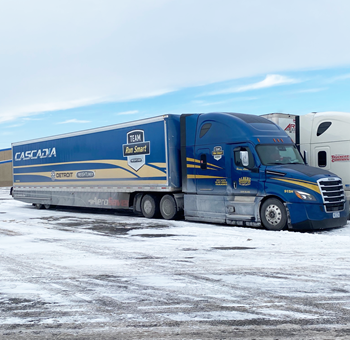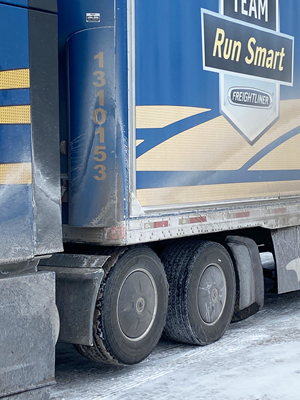.png.aspx?lang=en-US&width=300&height=225)

As many of you know, I’m now in my new 2022 Cascadia named Celeste! One of the features that I’m excited about is the Hendrickson OPTIMAAX 6x2 liftable pusher axle configuration, which has been outfitted in Celeste. Many people shy away from 6x2 axle configurations because they’re concerned with traction during inclement weather or less than ideal terrain. I understand where this fear comes from, as I have operated multiple 6x2 tag axle-equipped trucks. With a 6x2 tag axle, there is an electronically controlled air suspension or (ECAS). What ECAS does, is shifts more weight onto the driven axle when wheel slippage is detected through the anti-lock brake system (ABS).
The difference between a 6x2 tag axle and a 6x2 liftable pusher axle, is that a tag axle will not completely shift weight to the driven axle. The tag axle system always keeps a minimum weight applied to the non-driven tag axle. On the 6x2 liftable pusher configuration that I’m employing in my current Cascadia, the system will not only bias weight towards the driven axle when traction is compromised, but it will also completely lift the pusher axle in lightly loaded circumstances.
As most of you know, my normal routes don’t take me into areas where traction is compromised on any kind of a regular basis. In reality, of the 365 days a year that we can operate a truck, how many days is traction really an issue due to inclement weather? So, when I had the opportunity to take Celeste on a trip where I knew snow would be encountered, I immediately took it! What made this trip even more challenging, was that the loads were going to be extremely light for both directions of the trip. The loaded weight on the northbound trip from Laredo, TX to Des Moines, IA was only under 6,000 lbs. And the return load from Trenton, MO to Laredo, TX was under 12,000 lbs. This meant that I was able to run with one axle lifted on the tractor, and one axle raised on my trailer, as it’s also equipped with a liftable axle assembly. As it turned out, I did not encounter snow until loading at Trenton, MO. I would have liked to have been able to see how the system would've worked in the snow with the lighter load, as well as during the 147 miles empty from Des Moines to Trenton.
After I was loaded and the trailer axles were slid to maximize my weight distribution, I was able to scale out the load on three axles. Because I’m new to this particular system, I paid to weigh the truck to confirm the weights per axle, which I had estimated with air pressure. There were 13,160 lbs on the steer axle, 17,300 lbs on the drive axle, and 13,520 lbs on the trailer axle.
Being this light is not what most truck drivers look forward to when encountering snow-covered roadways, and being that this was my first time having this configuration, I “played around” a little in the industrial park before heading out to the open highway. The industrial park was quiet with no traffic, so I was able to test out the braking capabilities at relatively slow speeds, so that I had a better understanding of how the truck and trailer would react in a panic braking situation. I was pleased with the fact that the truck stopped nearly straight as an arrow. It’s amazing to me how well all of the modern ABS and stability control systems work in harmony with the driver, in order to maintain directional control in less than ideal conditions.
With all this being said, I encourage everyone to drive in a manner where these systems will not be engaged. Keep these increased capabilities in reserve for unexpected situations.
As far as traction, the truck pulled out effortlessly on its Michelin X ONE LINE ENERGY D wide-base single drive tires. Keep in mind that this tire is marketed more as a premium fuel mileage tire, than an extreme traction-oriented tread design. In these particular conditions, I felt as though on this day, and on that snow, the tires performed flawlessly.
Part of the reason for the traction being so good, in my opinion, was the fact that I had 17,300 lbs on one axle. The tire, with that amount of weight on it, would have its optimum footprint in regards to traction. In a tandem axle assembly, there would have been only approximately 8,650 lbs per axle, which would have been half the weight per square inch of the tire's contact patch.
I feel much better with one snowy trip in the rearview mirror. And in future posts, I will address the fuel savings, toll road advantages, and improved ride quality attributes that can be realized by employing the Hendrickson OPTIMAAX system.
